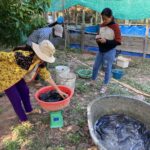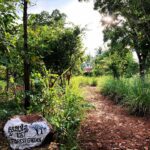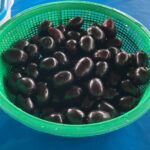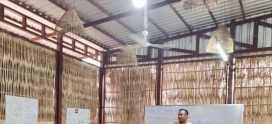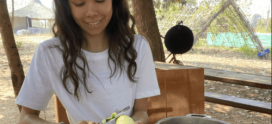Agritech Diary 2022 part 3
Green Shoots Operations Manager, Muneezay, is in Cambodia visiting the Agri-Tech Centre. Here is her second diary entry from the field!
In my first post from the Agri-Tech Centre I had mentioned my excitement about being in Cambodia during this time of the year- right after the Khmer New Year, just when the rainy season starts.
The dates for the rainy season are seen to be shifting thanks to climate change, but officially it is always somewhere between May till November, with most rain coming in August. Which coincides well with the traditional rice planting techniques and calendar of land preparation and seed sowing in May (after the famous bullock ceremony), transplanting in June and by the time the paddies fill up in August- the rice crop is peeking through. In October and November, Its a joyous to see the lush green paddies with enough water to suppress nasty weeds.
So it’s been raining steadily for a month- now what? From what I know, Cambodian’s do wait for the bullock ceremony to begin ploughing (this was at the end of May) but the rains have already been beating down hard nearly everyday. For the rice farmers, I can see this to be problematic- as they might not have started to transplant their rice but the paddies are already getting full, or the rice seedlings have not grown tall enough and can be at risk of drowning.
What about us at the Agri-Tech Centre?
Yes, we are still waiting for our ponds to fill up but the arrival of rain indicates a lesson in planning, in being prepared. What I began to understand was the knock on effects on food prices due to the rain. Water in the streams and ponds suddenly means an abundance of fish! the protien of choice, as it can be caught nearly every day. This meant the price of fish we had been nurturing for the last three months to sell in May suddenly fell. ofcourse! However, it was’t my first lesson in seasonality and the cost of things. I also remembered that the price of wood fluctuates according to rain, as the trees get wet and it can be harder to harvest. A real-time exercise in project planning that no online program will teach you.
While cribbing about the seasonal fluctuations in prices, I also become aware of the seasonal abundance during this time of the year. Fish in the rivers and paddies, mushrooms in the undergrowth (and Khmer’s have an innate knowledge of edibles), fruits on trees. In that awareness, I also begin to notice the rhythmic activities of locals preparing freshly caught (or bought) fish and drying it in the sun, cleaning up a mushroom haul from the forest to be fried up, a higher intake of leafy greens and mountains of fruit in the market. Just today my guesthouse owner served up mushrooms she had picked yesterday “num prey”- forest food!
While this rhythm is currently dictated by royal ceremonies in a restrictive way, the untimely opening up of skies due to climate change can either upset activities drastically or force people to adapt. The last ten years has shown sometimes in Oddar Meanchey the rain comes early or sometimes not at all. I feel the impacts of shifting monsoons are worse on those who depend wholly on it as a livelihood, who are usually the ones unable to access information or change their practice. Their wriggle room for adaptability being limited due to socioeconomic constraints.
For this year and the coming years, we hope to learn from our community their natural ways of yearly planning and foraging according to the seasons- living the true meaning of a sustainable diet. In return, from the Agri-Tech centre, we also hope to improve their resilience to shocks, wriggle room for adaptability and provide better coping mechanisms and increase access to new techniques.
To get more instantaneous updates of what we are getting up to, you can follow us on instagram https://www.instagram.com/greenshootsfoundation/



